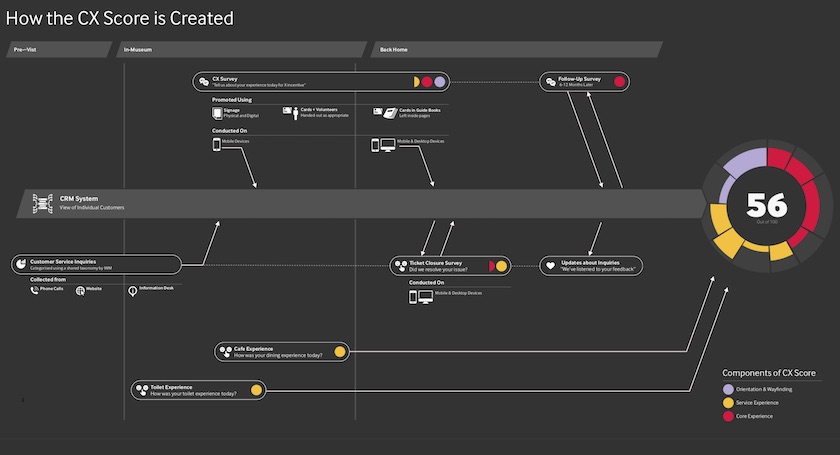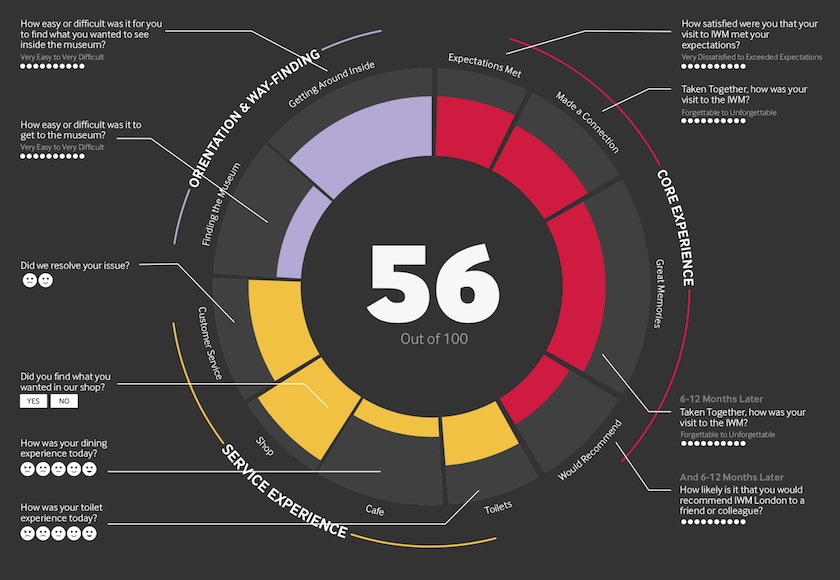CX strategy: CX measurement and the cultural sector
Storytelling is the lynchpin of museums and cultural organisations, but it’s often overlooked when measuring CX. Here Experience Director Jamie Stantonian explores how to develop a CX strategy that puts the role of stories centre stage.
Cultural organisations and the role of storytelling
When Inviqa was tasked with creating a customer experience improvement framework for the Imperial War Museums, executive director John Brown was keen to emphasise that the London museum ‘is about stories’.
The Imperial War Museum (IWM) is a repository of the memories of people whose lives became entangled in the momentous and tragic war events of the 20th and early 21st centuries. People come to the museum to hear these tales, but also to share stories of their own, and those of their ancestors.
One visitor, for example, was so fascinated by an IWM volunteer’s stories about a V2 rocket that he chose the museum as the location for a company-wide event, so that other staff members had a chance to hear the stories he’d heard.
Another museum employee described the moment in 1920 when a woman gave the IWM a photo of her only son who died in the Great War. It was the only image she had of him, at a time when photography was still prohibitively expensive for many, but she reasoned that it was better for the museum to share his story with future generations than have it die with her.
It’s these sparks of human connection that stick with people and their museum experience. Even as Covid forces our lives online, and closes our physical cultural spaces and museums, storytelling remains key to how cultural organisations continue to achieve their strategic goals and stay relevant to their audiences.
Indeed, the role of stories may be more important than ever, as Tate digital director Hilary Knight explains:
As well as creatively responding to the situation we are in right now, there is a chance here to create stories that explore who we might become...stories that help to articulate who we are now as a society...as communities, families and individuals…
So if storytelling is so important to how cultural organisations achieve their goals, how can we measure how effectively we’re telling these stories, and how this impacts the customer experience?
CX strategy starts with defining CX
Stories and memories are as central to measuring customer experience as they are to a cultural organisation’s raison d'être.
But before defining a CX strategy and measurement framework, it’s really important to gain a shared understanding across key stakeholders of what the organisation actually means when you talk about customer experience.
Early into our workshops with Imperial War Museums, we came up with the following definition:
Customer experience is the customer’s perception of the sum of all interactions between the customer and the organisation – across every touchpoint, and for the entire lifecycle of the relationship.
It’s a neat definition, but how do we use this as a foundation for measuring something as expansive and intangible as human experience?
A useful starting point is Daniel Kanheman’s landmark book Thinking Fast and Slow in which he popularised the idea of our two selves:
- the experiencing self, which is entangled in the mental and emotional now i.e. ‘the you’ that’s reading this blog post right now; and
- the remembering self, i.e. ‘the you’ that constructs a narrative out of what you’ve read based on your experience ‘peaks’ and conclusion.
Measuring how CX shifts over time
Crucially, Kanheman’s research shows that our memory of an experience can differ quite drastically from our experience in the moment.
In the case of a museum, the experiencing self might find their museum visit a bit lacking, but the remembering self might recall it more fondly where there’s been a single moment of fission, which makes for a powerful emotional connection.
At the same time, an otherwise enjoyable day out at the IWM could be spoiled by failing to find the loos in time of need, or feeling short-changed by the cafe.
Over time, these ‘peak’ experiences, characterised by their high affective quality, become the only thing you remember in the future.
The final aspect of this is expectation, which provides the mental context of the experiencing self. Cognitively speaking, expectations are anticipations of future memories, and we of course feel short-changed if they turn out to disappoint us.
So, if what the visitor has seen online, in a poster, or in a review differs substantially from what’s experienced in the moment, the chances of a cranky review on TripAdvisor are far greater.
To measure experience then, is to take into account the experiencing self, whose context is expectation, together with the future recollections of the remembering self.
What this means in practice for us is the need to gauge how a visitor’s experiences in the moment evolve over time.
Informing CX strategy with user research
Imperial War Museums recognised that storytelling was absent from how performance was measured and how decisions were made.
Our research showed that while many cultural organisations were using measurement frameworks to try and quantify and assess customer experience, few felt they were getting it right.
So the Inviqa team was tasked with developing a new CX measurement framework that would put storytelling at the heart of CX strategy, and would enable the organisation to understand and measure customer experience as a business imperative.
Our research showed that while many organisations were using measurement frameworks to try and quantify and assess customer experience, few felt they were getting it right.
It’s little surprise considering there’s not really a univeral template for doing this well; many of the off-the-shelf customer experience frameworks outlined in literature are comprehensive and complex, but in reality are totally impractical to implement.
The challenge then is finding a customer experience framework that sits in the ‘Goldilocks zone’ of being easy-to-implement and manage while being empirically meaningful – measuring what’s important and providing actionable information.
To measure both the experiencing and remembering self, our approach for IWM includes a rapid, incentivised, on-site survey, which visitors can complete on their own mobile devices.
The emphasis is on capturing the immediacy of the in-the-moment experience, and how well a visitor’s expectations are being met. A sliding scale allows users to rate their experiences from ‘forgettable’ to ‘unforgettable’ (the latter representing the ‘peak’ experience), with the option to share more detail.
Then, in 6-12 months’ time, via the magic of CRM, the same users are asked what they remember most about their trip.
The idea is that, by comparing sufficient qualitative and quantitative data, we should be able to see which elements of the experience are most powerful, both good and bad, and how this may shift over time.
Defining a CX measurement framework
Taking this all into account, it made sense to split our core customer experience into three chronologically distinct segments:
- expectations
- whether meaningful ‘peak’ experience was achieved
- the remembered experience
These three elements were combined with the Net Promoter Score (NPS) to constitute our ‘core’ experience and the first pillar of our CX Score. But there were other elements to take into accounts.
The interviews with volunteers, customer service reps and other frontline staff, combined with a close reading of complaints data and feedback on Tripadvisor, allowed us to get a good feel for what really mattered to people.
While there are a core group of visitors who are invested in the more intellectual aspects of the museum, many others just want a pleasant day out (aka ‘a view, a brew, and a loo’). So measuring the quality of the cafe and the loos with a Customer Satisfaction (CSAT) score was essential.
The geography and layout of the London museum site posed its own issues. Knowledge of these issues was widespread but unmeasured. So, to measure wayfinding and orientation effectively, a Customer Effort Score (CES) was appropriate. The final element was The Service Experience to gauge the quality of the shop, cafe and facilities.
Weighting the CX measurement framework
Having identified the important elements, we mocked up the foundations for our CX score, but still needed to ask the right questions to fill in the unknowns.
Using our experience mapping, we identified what we needed to be asking and when, and the corresponding metrics we’d collect for each of these.

Above: defining an experience map for the museum
We then needed to determine how important each of the segments was to the total score. In order to find out these weightings, customer service staff at IWM completed a card sorting exercise to rank each element of the score in terms of importance.
This then became the initial weightings of the score which were verified with customers. Unsurprisingly, ‘hearing powerful stories’ ranked as the most important element of the visit, with the cafe and shop ranking the least important.

From January to March 2020 we piloted this survey in IWM London and gained enough responses to start to create a baseline score and measure the different elements of the customer experience.
While we wait until the museum reopens later in the year, there is some tantalising initial evidence in the meantime of the intoxicating power of stories.
In the survey we asked people if they made a personal connection to an exhibit or story during their visit. When they answer in the affirmative, something every interesting happens: all of the other metrics are higher.
In other words, making a connection with stories fundamentally transforms CX, improving a visitor’s perceptions of their visit.

Above: the CX score concept design
How to measure CX in disruptive times
The result of our partnership with IWM is a measurement framework that provides a CX score using a weighting system based on what matters most to the business and its audiences.
The IWM is in the final stages of a restructure that will put greater emphasis on customer experience. This will be tracked and launched in earnest using our CX Score when the museum reopens.
That said, the approach we piloted (pre Covid lock-down) to measuring customer experience remains a really useful tool even while the doors to our museums and cultural buildings remain closed.
This global crisis has forced us longstanding cultural institutions to move much more quickly than we usually do. We must continue being agile, experimental and responsive if we want to endure.
Many organisations are pivoting to things like virtual exhibitions and online collections, and by attempting to measure these experiences (across both the experiencing self and remembering self), cultural organisations can arm themselves with crucial insight into how they can tell stories through digital channels while we live our lives online.
By crafting measurement frameworks, informed by quantitative and qualitative user research, cultural organisations can get into a position where current and future propositions can be built on evidence, not assumptions.
Wrapping up
Our work with Imperial War Museums shows why storytelling is key to helping cultural organisations deliver compelling customer experiences that support their strategic goals and mission statements.
Developing an effective and tailored CX measurement framework helps our cultural organisations put storytelling at the heart of CX, and put CX at the heart of performance.
By demonstrating that helping museum visitors connect with a story dramatically improves the overall customer experience, we’ve helped IWM optimise around this and establish the CX score as a core KPI.
The organisation has now orientated different teams around this central metric and recruited for new CX manager positions within the organisation.
Crucially our work with IWM is helping identify how and where the organisation can provide a ‘peak’ experience to a user, helping to keep its stories alive for decades to come.



